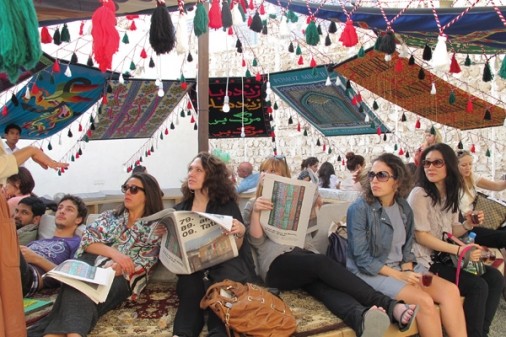Slavs and Tatars
10 Feb - 24 Mar 2013

© Slavs and Tatars
Friendship of Nations: Polish Shi’ite Showbiz, 2011. Installation view, Sharjah Biennial 10, Sharjah, United Arab Emirates. Courtesy the artists.
Friendship of Nations: Polish Shi’ite Showbiz, 2011. Installation view, Sharjah Biennial 10, Sharjah, United Arab Emirates. Courtesy the artists.
SLAVS AND TATARS
Friendship of Nations: Polish Shi’ite Showbiz
10 February - 24 March 2013
Friendship of Nations: Polish Shi’ite Showbiz is an examination of the unlikely points of convergence in Poland and Iran’s economic, social, political, religious and cultural histories, from seventeenth-century Sarmatism to the twenty-first-century Green Movement. For the most comprehensive exhibition of works from Friendship of Nations, Slavs and Tatars, an international collective of artists, designers and writers, presents a range of sculptural objects, woven tapestries, lecture performances and photographic murals that address how the two countries’ respective efforts toward self-determination have shaped the larger geopolitical landscape, punctuating the major narratives of Communism and Islam in the twentieth- and twenty-first-centuries. Devoting its research-based practice to the area commonly referred to as Eurasia, a geography the group identifies as being “east of the former Berlin Wall and west of the Great Wall of China,” Slavs and Tatars’ works span disparate media and graphic traditions to focus on an oft-forgotten sphere of influence between Slavs, Caucasians and Central Asians.
Friendship of Nations: Polish Shi’ite Showbiz
10 February - 24 March 2013
Friendship of Nations: Polish Shi’ite Showbiz is an examination of the unlikely points of convergence in Poland and Iran’s economic, social, political, religious and cultural histories, from seventeenth-century Sarmatism to the twenty-first-century Green Movement. For the most comprehensive exhibition of works from Friendship of Nations, Slavs and Tatars, an international collective of artists, designers and writers, presents a range of sculptural objects, woven tapestries, lecture performances and photographic murals that address how the two countries’ respective efforts toward self-determination have shaped the larger geopolitical landscape, punctuating the major narratives of Communism and Islam in the twentieth- and twenty-first-centuries. Devoting its research-based practice to the area commonly referred to as Eurasia, a geography the group identifies as being “east of the former Berlin Wall and west of the Great Wall of China,” Slavs and Tatars’ works span disparate media and graphic traditions to focus on an oft-forgotten sphere of influence between Slavs, Caucasians and Central Asians.
